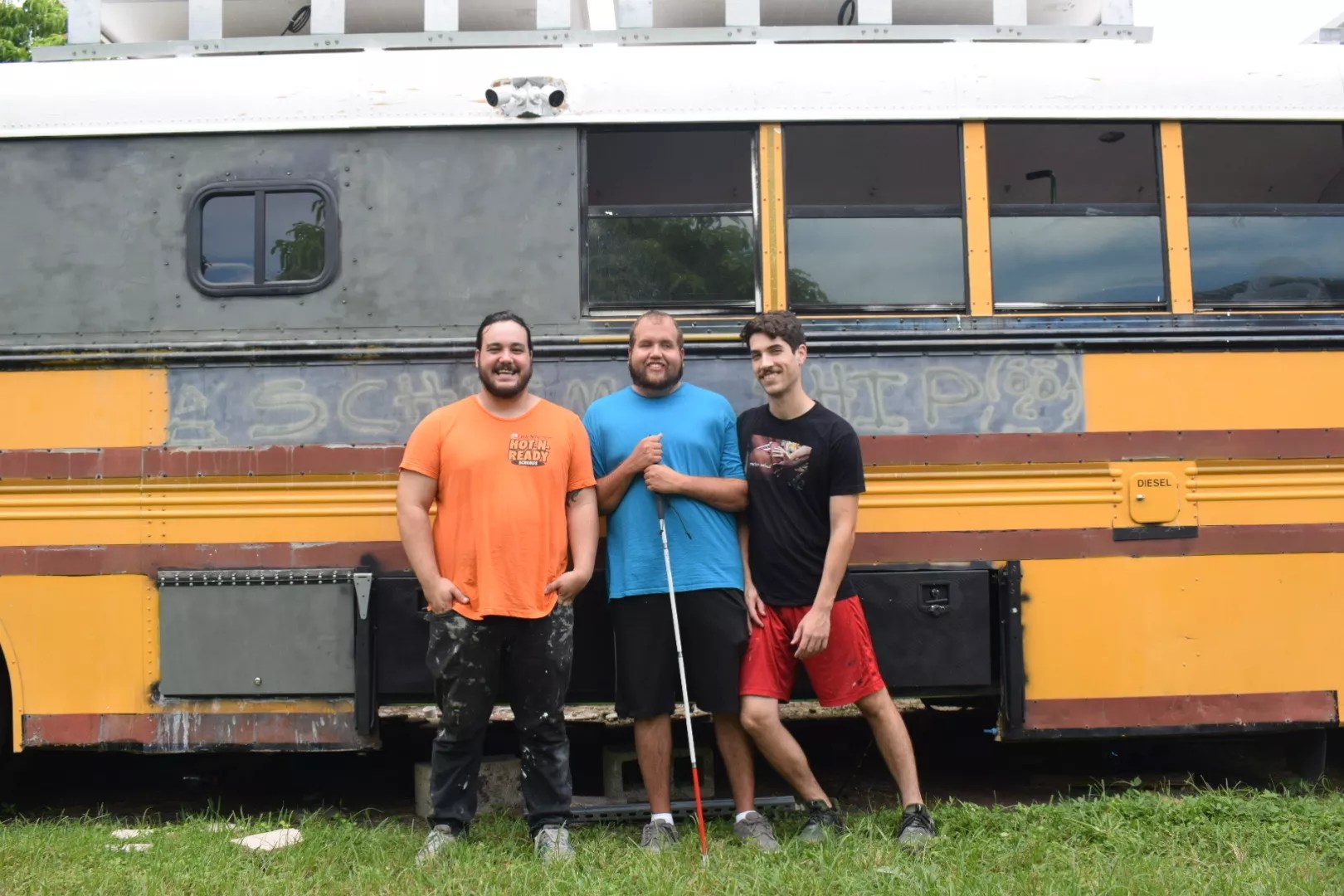
Photo by Nicholas Olivera

Audio By Carbonatix
After crawling out from underneath the school bus, the diesel mechanic proclaimed, “I would drive it across the country right now.”
That was good news for David Martin and Sebastian Rodriguez, who were in Orlando to potentially purchase the bus. Their knowledge of diesel engines extended only to YouTube videos and bus-conversion forums.
“Ninety-three-thousand miles – it’s like brand-new,” the mechanic added.
With the wrench man’s blessing, the two young men purchased the yellow behemoth without informing their best friend, Chris Silio. The group had all met while cutting their teeth in Miami’s emerging comedy scene.
When news happens, Miami New Times is there —
Your support strengthens our coverage.
We’re aiming to raise $30,000 by December 31, so we can continue covering what matters most to you. If Miami New Times matters to you, please take action and contribute today, so when news happens, our reporters can be there.
“I went blind at 18,” Silio says. “And I decided to start doing standup six months after that, and the first time I thought, I’m not doing anything else.”
The trio bonded over shared interests and soon crossed a threshold that social psychologists will one day refer to as the Step Brothers moment – when two or more like-minded individuals dumbfoundedly pose the question: Did we just become best friends?
Silio jokes that the moment came during an outing to the Okeechobee Music Festival, when they “found out the power of skipping lines” courtesy of his visual impairment.
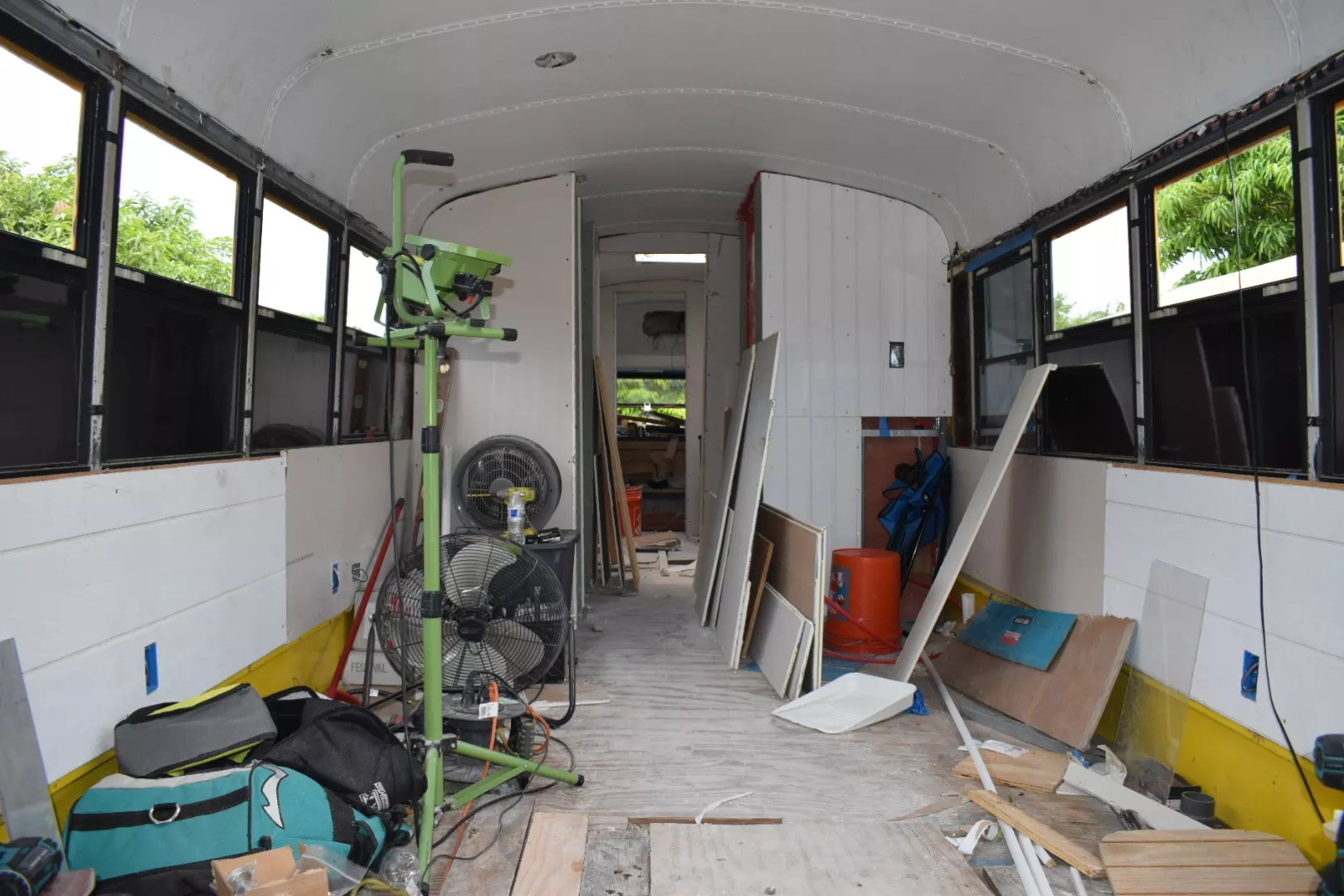
The interior of the Scheme Supreme bus.
Photo by Nicholas Olivera
This is where the idea of mobile domestication was first proposed.
“I had already been thinking about vans and then bringing it up,” Rodriguez recalls. “‘Imagine if we were here – with a van.’ And then we kept fantasizing about it for a year.”
Eventually, the fantasy of driving around in a van morphed into driving around in a school bus. In it, the trio could travel the nation and hit every city with a comedy club, building an audience while sharing their adventures online. Living out of a converted school bus seemed more viable than the usual route for aspiring comedians.
“‘Welcome to New York! Here’s the line. There’s a thousand people ahead of you. Go try to impress,'” Rodriguez says facetiously. “We’d be living in the same square footage, but at least we own this. We’re not paying rent to anybody. The only rent that we would have to pay, if done correctly, would be like gas.”
While still fantasizing about freedom on the road, Martin and Rodriguez immersed themselves in the culture of bus conversion online and shared prices of buses up for sale.
Soon the pair found themselves in Orlando, face-to-face with a bus that fit their criteria: a flat-nose model with low mileage and a diesel engine located in the rear. It was affordable – and close enough to home to transport and begin the conversion process.
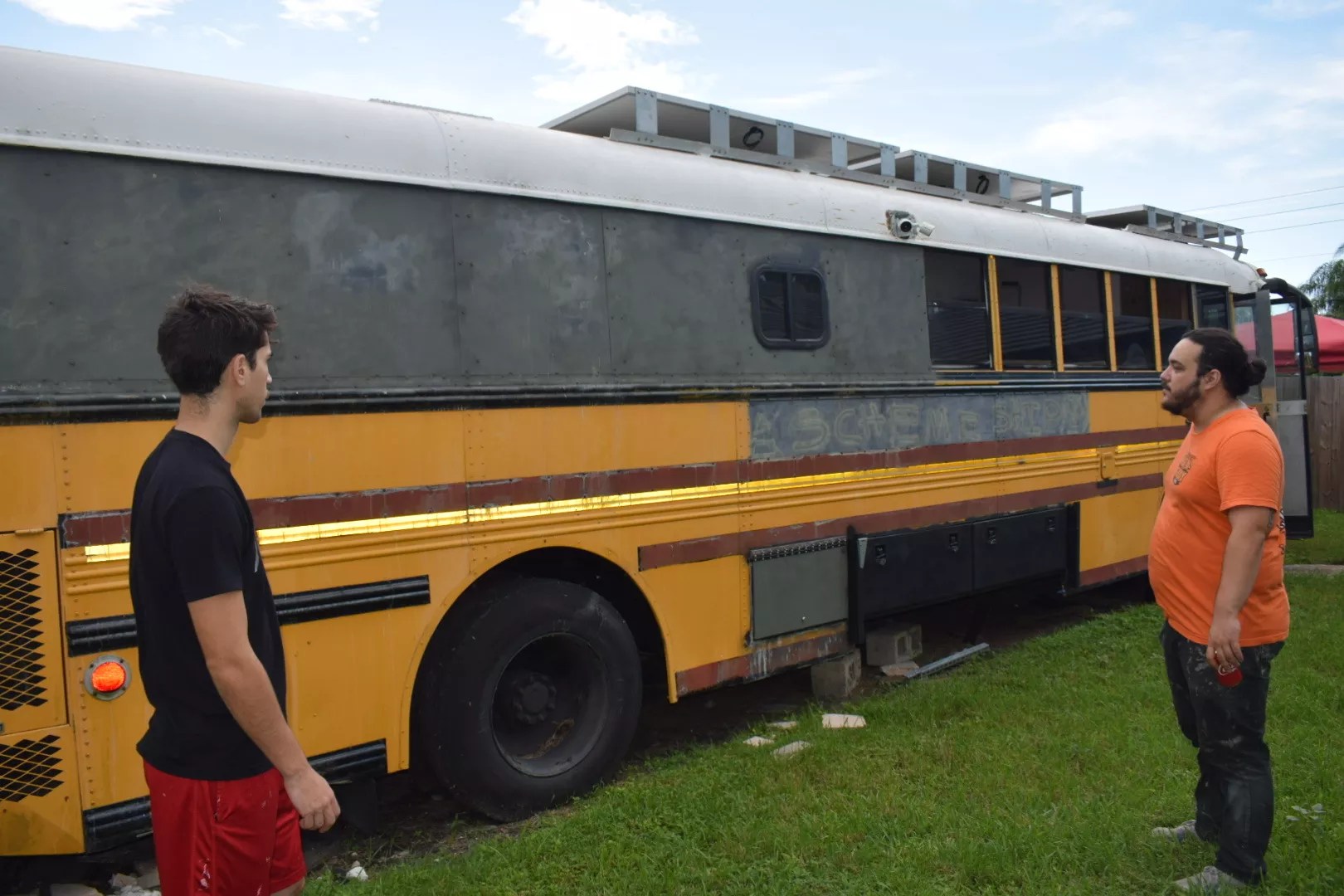
The Scheme Supreme bus is parked in Chris Silio’s parents’ backyard.
Photo by Nicholas Olivera
Martin and Rodriguez bought the bus and intentionally kept Silio in the dark.
“It would be a good video to surprise him,” Martin says of the decision.
When they returned to Miami, they told Silio they had to go up to Orlando for a comedy show. Silio was skeptical but ascended the steps of the school bus.
“Where is this comedy show?” he wondered aloud. “In a treehouse?”
“Once I felt one of the chairs, I go, ‘This is a bus,'” Silio remembers. “And they go, ‘This is our bus.'”
Bus acquired, the trio needed a place to store it back in Miami. With few options that would allow them to store tools and raw materials, the idea of using Silo’s parents’ backyard came up. Martin and Rodriguez had never met Silio’s parents, so Silio laid out the situation in plain terms.
“It wasn’t, ‘Hey, I’m thinking about buying a bus,'” Silio says. “It was like, ‘Hey, I have a bus. I need a place to park it right now.'”
His parents were understandably skeptical. His father went so far as to offer to help finance an RV for the trio’s cross-country adventures, but the allure of the project was to turn a school bus into a livable space.
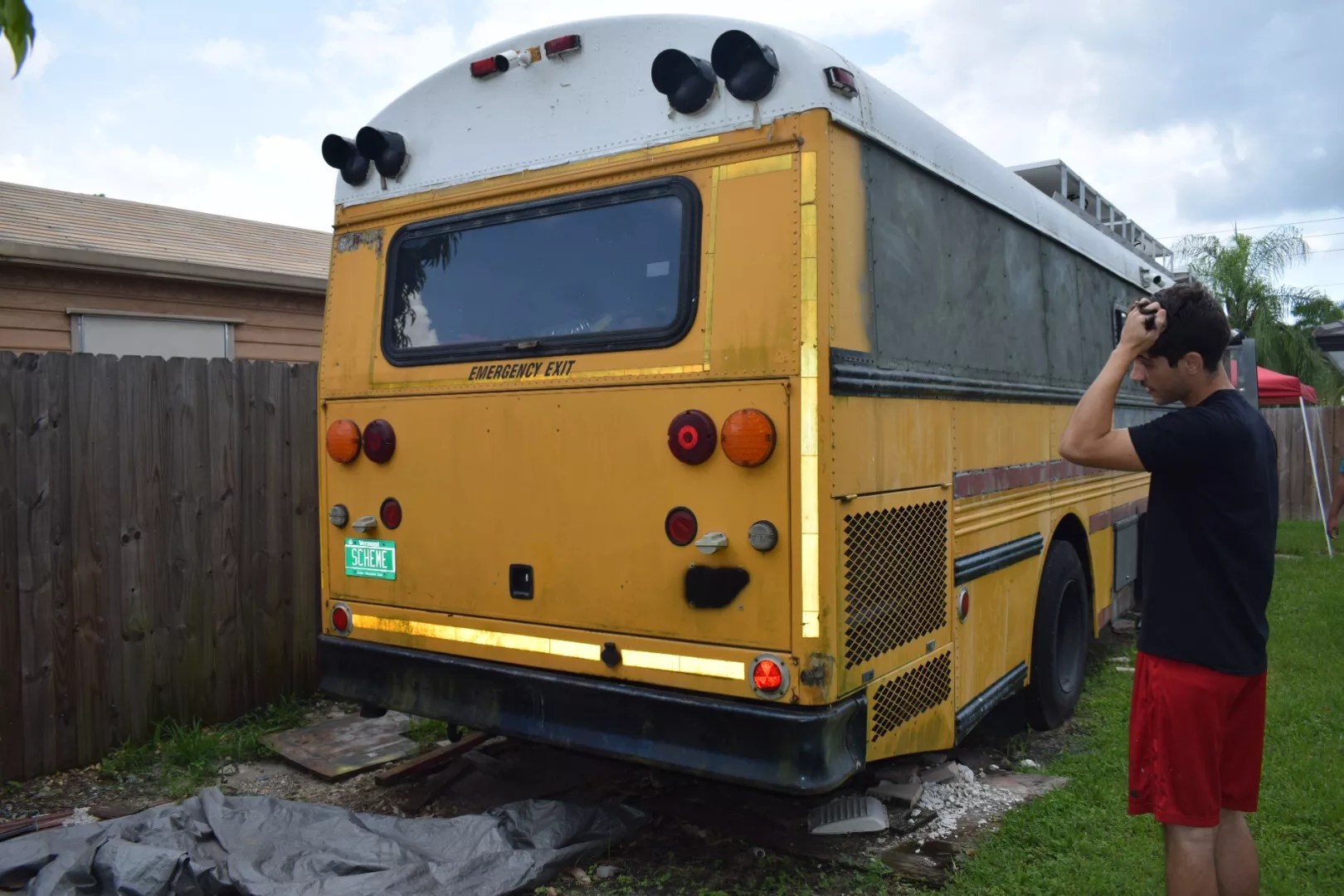
It’s been almost three years, and the bus conversion still isn’t completed.
Photo by Nicholas Olivera
“It was about learning something and building something with your friends,” Rodriguez explains. “Learning all the things that make you a ‘traditional man’ – of fixing things and electricity and plumbing. I wanted to build this.”
Silio’s parents relented and allowed them to park the project in their yard.
That was almost three years ago, and the bus conversion still isn’t completed.
“It’s been years now, and people close to us are asking, ‘What’s up with that thing you’ve been doing?'” Martin says. “Normally, things produce noticeable results. Like, for example, when we were working on the bottom of the bus – nobody sees that. Nobody sees the plumbing getting done, nobody sees all the rust being removed.”
The bus is functional, but the interior remains littered with tools, raw materials, and water bottles.
Since taking on the project, the comedic trio has dubbed themselves Scheme Supreme and documented the process across Instagram, TikTok, and YouTube. Over the past three years, they’ve amassed over 20,000 views on YouTube, 2,000 followers on Instagram, and two work-related hospitalizations. (To their surprise, Silio is the only one to have avoided significant injury.)
There’s certainly a learning curve when it comes to a project of this magnitude. And within this one big project are hundreds, if not thousands, of smaller projects in need of completion.
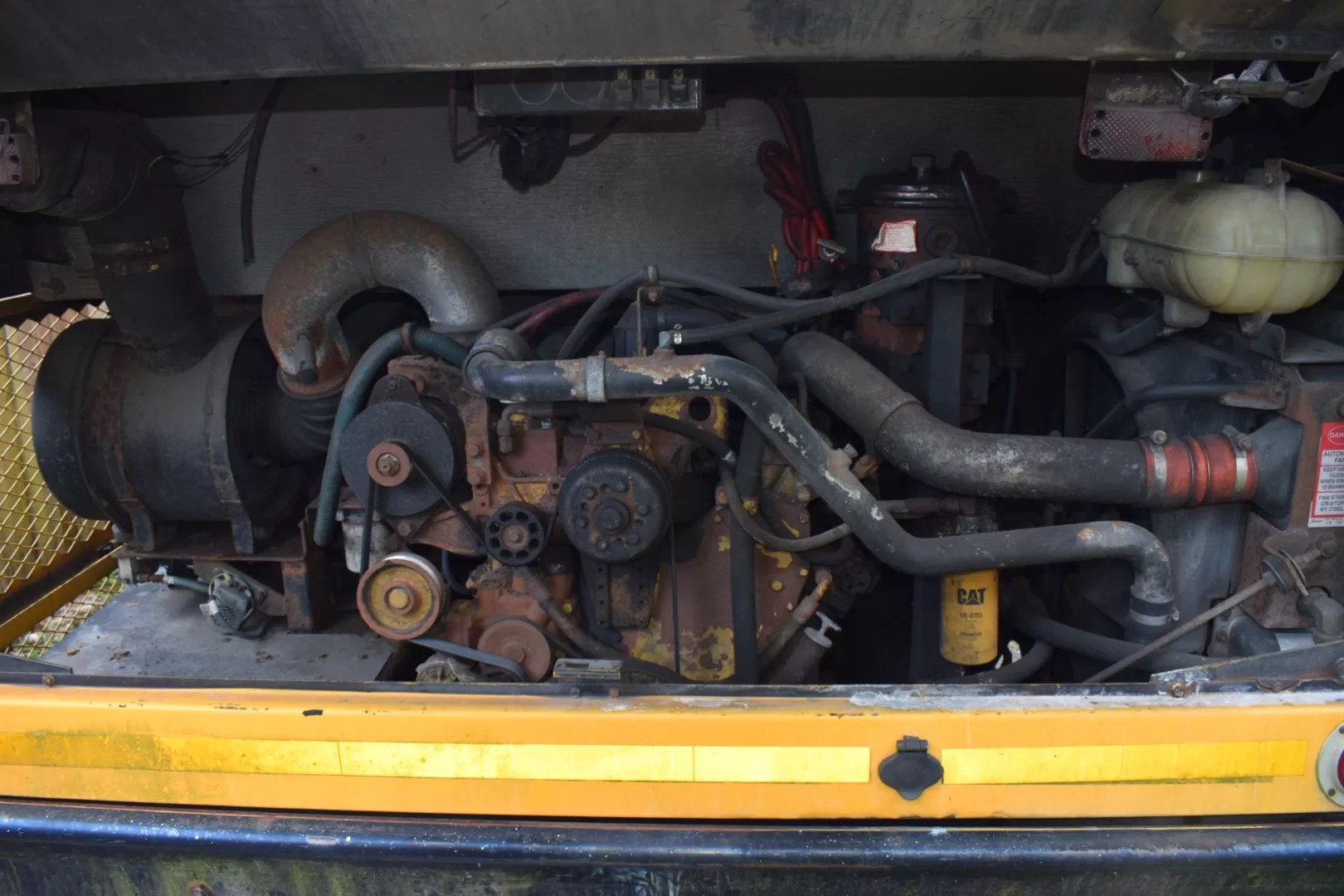
The trio has documented the entire bus-conversion process across Instagram, TikTok, and YouTube.
Photo by Nicholas Olivera
“Everything we do we do three times. We do it, we undo it, and then we redo it,” Rodriguez says.
A prime example: the water supply. The bus came with two tanks: a 50-gallon freshwater and a 75-gallon graywater. The plan was to swap out the freshwater tank for a 75-gallon one. That required finding a way to lift the bus off the ground high enough to do the swap, but even when they elevated the vehicle as high as they could, it wasn’t enough to switch tanks. They resorted to digging a trench beneath the bus to give them the additional space.
After the tanks were swapped, Martin’s father, an engineer, took a look at the undercarriage. He informed the trio that they had enough room to attach both the 75- and 50-gallon freshwater tanks side-by-side, but it would first require unmounting the 75-gallon tank.
They were split on whether they wanted to go through the process of unmounting and remounting the water tanks all over again.
Rodriguez wanted to leave it alone.
“It took us like a week, two weeks of just arguing about it before we decided to actually do it. I was just being a big baby,” he recalls. “‘I don’t wanna fucking do it! I don’t give a fuck! It’s enough water!'”
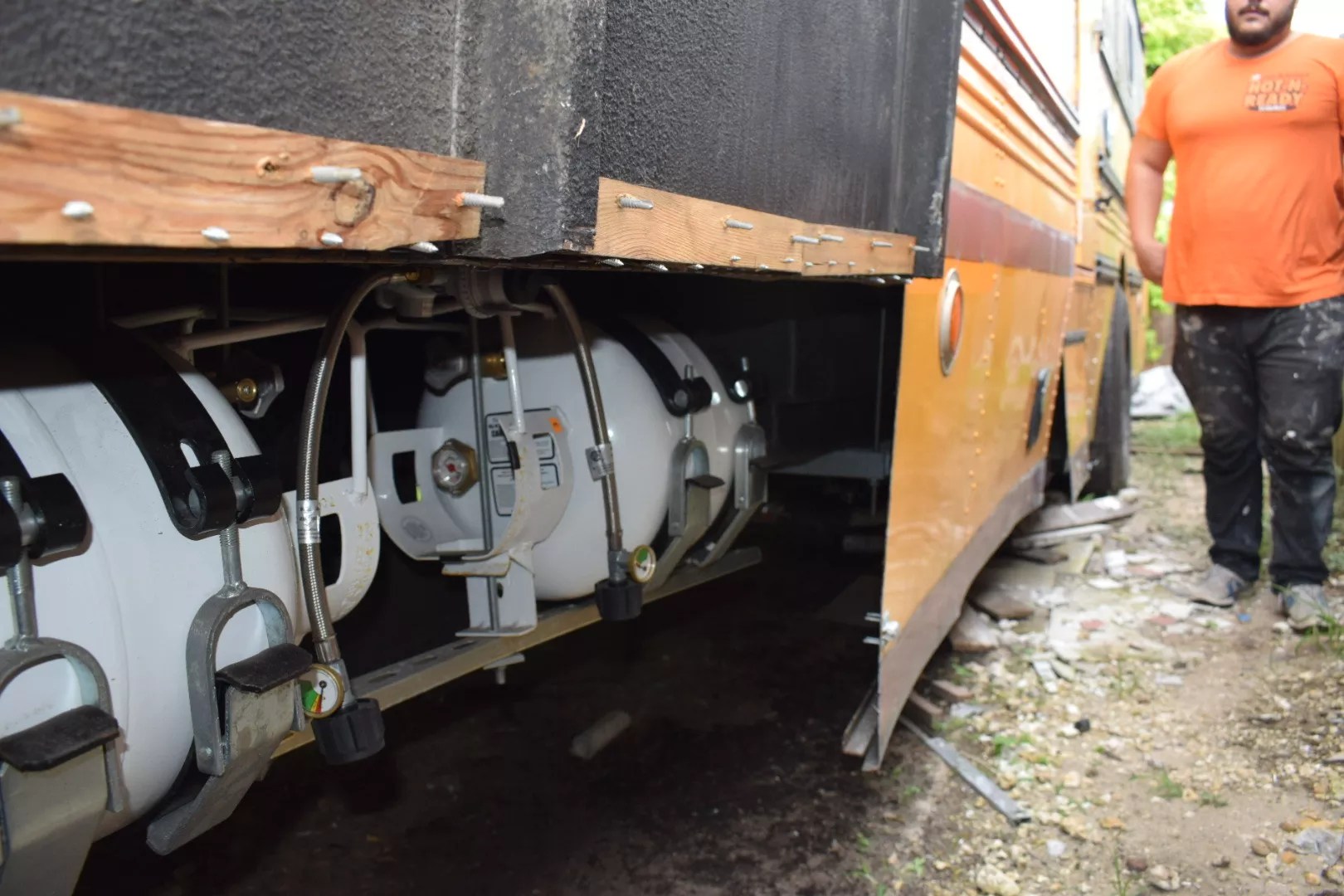
The objective of Scheme Supreme isn’t a bus conversion meant for short excursions.
Photo by Nicholas Olivera
Eventually, he relented.
“None of this [the bus] is intended for the purpose we’re trying to do it for. This isn’t intended to hold water tanks on the bottom area,” Martin says. “You have to like drill weird angles to get a good hole to put a bolt in, to hold the threaded rod that holds the frame that holds the tank, and it’s really fucking annoying.”
The objective of Scheme Supreme isn’t a bus conversion meant for short excursions. Because the trio aims to take the bus on the road for long periods of time, certain adjustments are required to adapt it to its new purpose.
“You have to work around the bus,” Rodriguez says. “It’s not like someone built a school bus for children where they’re like -“
At which point Martin interjects, “‘What if those kids needed to survive?'”
Follow Scheme Supreme’s conversion process on Instagram, TikTok, and YouTube.